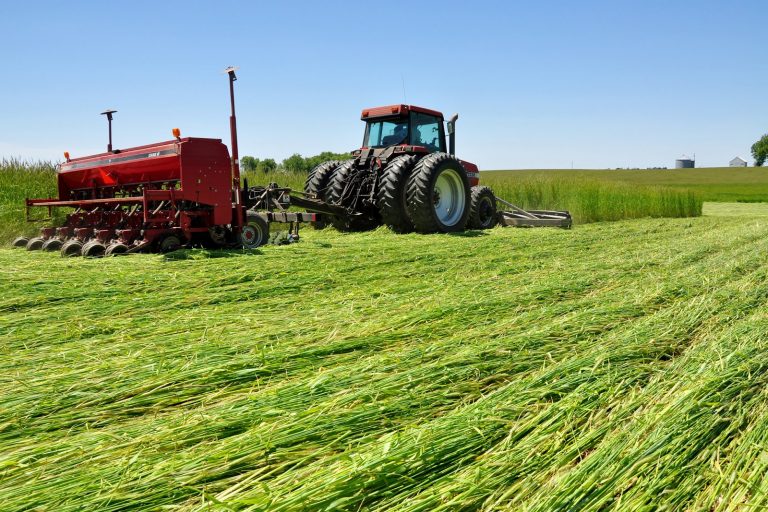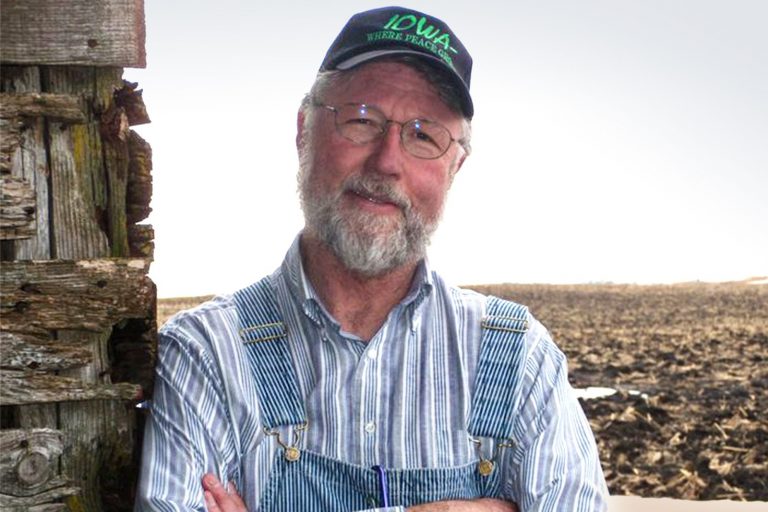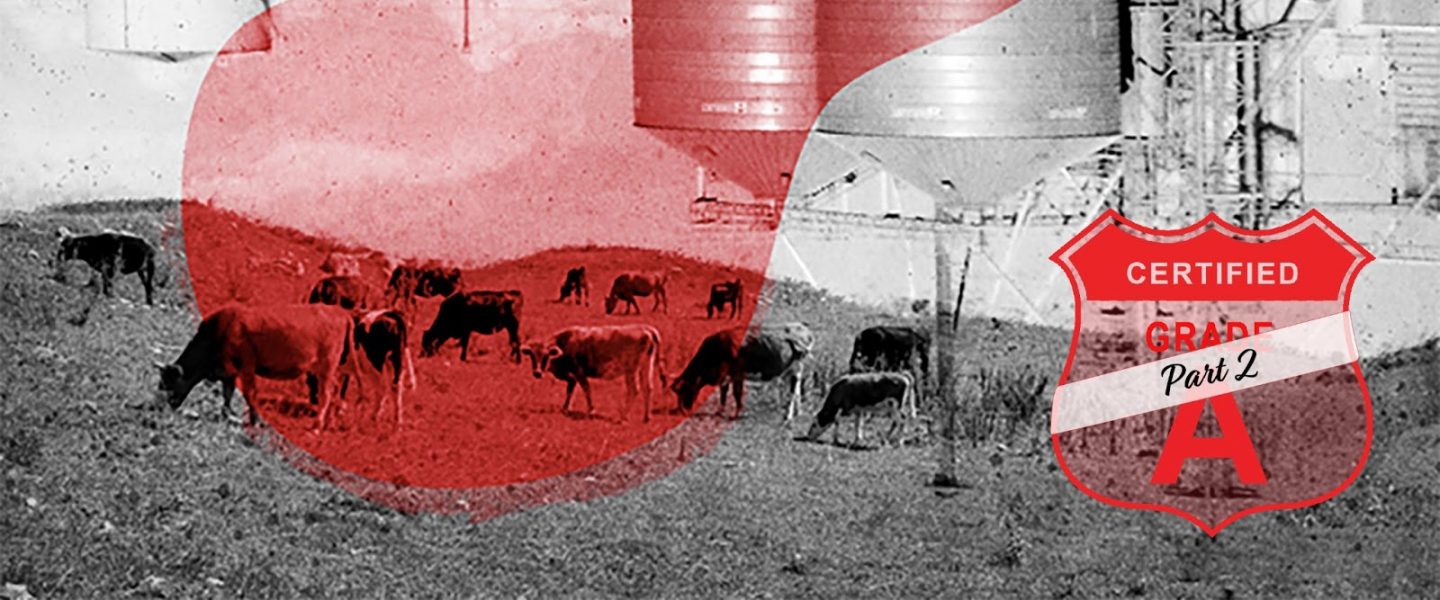The USDA bets on farmers to lead the shift to net zero carbon emissions. Struggling with below-cost crop prices and industrial takeover, they have other things to worry about.
This story is part of Covering Climate Now, a global journalism collaboration strengthening coverage of the climate story. See Part 1 of this series here.
“If you want to think of an industry or an aspect of our economy that makes the least sense ecologically and socially, it would be agriculture,” said George Naylor. A seasoned Midwestern dirt farmer with a pronounced activist streak, Naylor has routinely locked horns with the agricultural industry, in tractor-cades marching on city halls, as lead plaintiff in a class-action lawsuit against biotechnology company Monsanto, and protesting international free trade talks stateside and abroad.
The end of June concluded Naylor’s seven-year journey away from conventional farming: All of his fields are now certified organic. Corn, soybeans, and oats crowd his 380-acre plot of land in Churdan, IA, planted in rotation to avoid depleting earth-bound nutrients. Clover and alfalfa, when plowed back into the ground, add biomass to the soil and inject growth-promoting nitrogen, and with more nitrogen coming from chicken litter, Naylor cut his use of synthetic fertilizer to zero. Winter rye grows after summer’s harvest and forms a mat-like mulch that suffocates weeds and helps eliminate the need for pesticides.
The practices Naylor adopted — rotating cash crops, planting cover crops, cutting synthetic fertilizers, in short, anything that regenerates and conserves soil health — tap into the enthusiasm for sustainable farming that now emanates from Capitol Hill to the countryside. They’re a mainstay for the Biden administration’s professed strategy to shrink agriculture’s carbon footprint — an estimated 10 percent of total US greenhouse gas emissions — while storing atmospheric carbon in the soil.
At the US-hosted climate summit in April, President Joe Biden touted the leading role farmers like Naylor would play in “deploying cutting-edge tools to make the soil of our Heartland the next frontier in carbon innovation.” In late May, the US Department of Agriculture (USDA) followed up on his remarks, publishing a 90-day progress report, a summary of 2,700 written comments and 10 listening sessions it held about how best to foster sustainable agriculture.

Having spent years working toward an ecologically sound way of farming, Naylor would seem to be ahead of the curve. But here’s the thing: Naylor doesn’t buy it. He doesn’t believe that calling upon farmers to steward the land will move the needle in any significant way. Not because he questions the ecological benefits of sustainable farming — he has witnessed the changes it brings to his own soil. But he sees farmers caught in the gears of an agricultural industry supercharged by free-market zeal that prioritizes cheap crops and labor above all else. In his view, farmers don’t get paid a living wage for their work, and as they try to stay afloat they’re drained of any autonomy to farm in a soil- and climate-friendly way.
“A farmer is nothing more than the front end of the raw material procurement process for manufactured food,” Naylor said, mentioning the 40-50,000 food items that stock the shelves of a typical supermarket today. “Virtually everything in the grocery store except the produce is manufactured. It’s processed.”
Less than 15 cents of every dollar spent on food at home goes toward paying farmers for their labor, according to the USDA’s Economic Research Service, a decline of 300 percent since 1990, when the farmers’ share was 59 cents. The remainder makes up for off-farm expenses, covering anything from processing and insurance to distribution and advertising.
“There’s no consideration for the people doing the farming.”
“The way that it’s always been, people that make money off of commodities do it by making sure that the commodities are as cheap as possible,” said Naylor. “But in that process there’s absolutely no consideration for the people that are doing the farming and are supposed to be taking care of the land.”
Farmers’ nominal portion of the food dollar goes back to what they earn per unit of crop. It’s been seven years since the price for corn covered its cost of production. The same is true for wheat. The return on soybeans has been fluctuating wildly between profit and loss, as the dollars per bushel at harvest follow the whims of the unfettered market. USDA commodity programs make up the difference for farmers for qualifying crops when prices or yields fall short, and to that end paid out more than $6 billion last year.
“There’s no telling how low the price is, so [farmers are] always trying to produce as much as they can because that’s the only variable they have that could make the difference in their being on the farm or not on the farm,” said Naylor. “In this competitive situation, some farmers are willing to do just about anything to make more money, either to survive or because they think they’re going to be millionaires. So they plough up more pasture, they cut down more trees.”
The price floor for agricultural products — analogous to a minimum wage — had been hacked away for decades and was finally demolished with the infamous 1996 Farm Bill, which sent prices, and the farmers relying on them, into free fall almost immediately. Naylor traces the slow devolution of farmer pay with each Farm Bill, spread out in four- to five-year intervals, all the way back to 1954 and Ezra Taft Benson: then-secretary of agriculture and an anti-Communist crusader for the far-right John Birch Society, to which he pandered with pamphlets carrying titles such as Civil Rights: Tool of Communist Deception.
“Once he said this: ‘Farmers need the spur of insecurity,’” recalled Naylor. “What he meant was: If you want farmers to produce their ass off, you want to make sure they’re insecure so the only way they’re able to survive is by producing as much as they can.”
Half the Heartland’s corn harvest — the portion that’s not turned into ethanol for biofuels, exported abroad, or processed into oils or syrups or flour or beer brewers’ grits — is fed to livestock in confinement, along with 70 percent of soy yield. With feed as their largest expense, depressed prices fueled the manic expansion of cattle feedlots and hog factories.

“That’s all that we have out here. The typical farmer in Iowa, they’re just raising corn and soybeans to feed corporate livestock,” said Naylor. “There’s been a progression, an evolution, all resulting from the price of corn, soybeans, and wheat and all the commodities being so low that it was cheaper to feed livestock in confinement and just buy all the feed. And whatever farmers you had left had no alternative but to raise corn and soybeans.”
There’s a Henry Fordist veneer of modern mass production to these livestock factories — they’re held as the inevitable endpoint of ever-greater efficiency in food production. That concept has been met with fierce criticism, as have the side effects of factory farming: hazardous working conditions that riddle hired laborers with chronic lung disease; antibiotics that keep animals alive in over-crowded pens and feed antimicrobial resistance in people; and massive amounts of liquid manure spread untreated onto fields that worsen nitrate pollution of US waterways.
“It’s all a matter of what’s called a misallocation of resources,” said Naylor of these downstream effects, none of which are accounted for in the price of food. “If a resource is underpriced where all of the costs of producing it are not included in the price of the commodity, then you’ve got two things happen: You’ve got obviously a system that produces that commodity by externalizing the costs, and you’ve got a cheap commodity that then gets consumed in irresponsible ways.”
The corporations that profit from this misallocation of resources dominate locally and operate internationally, and have become near-monopolies. JBS, Tyson, Cargill, and National Beef — the Big Four — slaughter more than 85 percent of the cattle that make up the country’s beef supply. The poultry and pork markets are nearly as concentrated: The top four companies in each sector slaughter more than 50 percent of broiler chickens and more than 60 percent of hogs.
These statistics on market concentration cause some economists to warn of market abuse — a century-old headache to ranchers that flared up in price-fixing allegations against the Big Four this year — but they are also an incomplete measure of the influence of meat processors. Not only do they grow their monopoly horizontally as they buy up assets of defeated competitors, they also spread vertically up and down the supply chain to take control of each stage of food production.
Smithfield Foods — the world’s largest pork producer, which is based in Virginia and is a subsidiary of the Chinese WH Group — isn’t shy about its vertical stranglehold. Its 2020 sustainability report details how the company partners with crop farmers, contracts with livestock growers, runs company-owned trucking lines, and founded its own genetics labs. All of those keep food nutritious and safe, the company argues, and make every move from farmers as transparent as the hogs’ genetic lines, which Smithfield can trace across the “entire pork chain, from breeding to farms to the final product.”
Along this vertical network, then, there’s a thread to trace from the dominant meatpackers to the livestock growers who sign contracts with them to the croppers that supply their feed. And as this thread weaves the corporate fabric that fits farmers like a straitjacket, there’s one question to answer: Which farmers exactly is Biden asking to lead the shift to net zero?
As Naylor suggests, most small farmers are not in a position to lead environmentally. They’re caught in an unrestrained, extractive industry that’s like others of its kind — those that drill the ocean floor for oil and gas or carry away mountaintops to extract coal and mineral ores. It has one principal aim: To mine the soil, not to keep it intact.

“It would take a revolution.”
Naylor’s criticism takes aim at the economics of agribusiness, an angle that comes naturally to him, perhaps because he graduated from UC Berkeley with a degree in mathematics in the early 1970s. Like Naylor, Ron Rosmann took over his family’s farm post-graduation, bringing back with him a biology degree from Iowa State University and what he calls the attitude of a farmer-scientist that naturally put him on the organic track.
“I was always a student of nature,” said Rosmann. “It really gave me a leg up on seeing the connections between how we farm, the farming practices, and what the outcomes are. Looking at the social effects too, the loss of community, the loss of people living out here in rural areas. Continual loss which has gone unabated all of my career here. That’s why I also fought so much for sustainable agriculture.”
At 71 years old, Rosmann tries to be at least somewhat retired. On his family’s 700-acre farm near Harlan in west-central Iowa, the work never stops. With his wife, Maria, and his sons, David and Daniel, Ron raises certified organic livestock on land that also supports a nearly endless variety of grains and legumes: corn for eating, corn for popping, soy, oats, turnips, wheat, barley, field peas, and millet. Coordinating the crop rotations each year keeps Rosmann sharp, and with 100 Red Angus cows and 50 sows, there’s always something being born.
Maria runs an on-farm store selling the family’s products as well as specialty coffees and teas. Daniel and his wife, Ellen, own Milk & Honey, a restaurant in town that sources its menu locally. Ellen runs a second business, a farm-to-table delivery service that buys produce from 60 small growers in the region and distributes it to restaurants, co-ops, cafeterias, and individual customers. The Rosmanns also market their products through the national cooperative Organic Valley.
Many of the USDA’s recommended conservation practices have long been part of Rosmann’s routine. Crop rotations keep the topsoil covered year-round and supply feed for the animals. Pests can’t easily match the rhythm of crop changes, which allows Rosmann to cut back on chemicals. He uses ridge-tilling to keep soil and its organic matter intact. He doubled the headland separating his plots from his neighbor’s and took it out of production to let it recuperate. And wherever he can find space, Rosmann plants trees and shrubs that attract wildlife and beneficial insects and act as a carbon sink. Recently he built a pond where waterfowl nest.
Rosmann began experimenting with such practices in the early 1980s when concerns over rapidly eroding soil and chemical runoff first surfaced. In collaboration with Iowa State University, he ran trials to see whether he could decrease fertilizer use. Lo and behold, he could, and by a lot.
“In other words, we were being oversold — and still are today — on how much fertilizer you really need to grow a decent crop,” Rosmann said. By his estimate, half of the nitrogen typically injected into soils is never used. “It is down in the Gulf of Mexico or it’s in our water or it’s in nitrous oxide, it’s up in the atmosphere. That’s where it’s at.”
Rosmann meets all his crops’ nutrient needs by composting hog and cattle manure together with the vast amounts of straw he harvests and uses as bedding for the animals. Some legumes like alfalfa and clover rely only on bacteria at their roots to pull nitrogen out of the air. “I have not purchased one pound of nitrogen since 1982,” he said, and pointed out that his yields don’t fall short. They’re at the county average, and without having to purchase fertilizers and pesticides, his net return per acre surpasses that of a conventional farmer’s.
“The typical farmer out here just listens to what fertilizer dealers and the chemical companies and seed companies tell them to do,” he said. “There’s a lot of peer pressure to stay within those boundaries of what conventional ag has in our rural communities and if you go beyond that you are considered an outsider. Peer pressure plays a huge role in what happens out here.”
Consequential guidance from the USDA is limited, and farmers are given a free hand in managing what they spread onto their fields. “No restrictions on anything involving inputs,” Rosmann said. “None.” The federal rules that do exist to protect soil aren’t necessarily enforced locally. Crop insurance, disaster payments, and other federal subsidies require participating farmers to protect highly erodible land. However, Rosmann said, “Nothing is enforced, by and large, by the individual counties, where it’s supposed to be enforced in terms of doing the basics that are required by the Farm Bill and by crop insurance.”
The precision agriculture that allows Rosmann to calibrate inputs and fine-tune soil health is at the core of a nonprofit organization he founded in 1986 to spread his knowledge to a wider audience. The Practical Farmers of Iowa helps farmers build resilient and diverse food systems.
“It’s a force in the state of Iowa, it really is,” said Rosmann. Membership has surged past 4,500, and Rosmann hopes to see the network spread across the state and partner with urban food supply systems, including the larger Omaha metropolitan area just across Iowa’s western border.
“The models that are going to predominate in the future are trying to be tested and sorted out right now. And what we need to do is encourage those experiments and encourage that kind of thinking,” said Mary Hendrickson, associate professor of rural sociology at the University of Missouri. She specializes in community food systems and market concentration and has for years worked directly with farmers through the USDA extension service.
Early June brought a windfall for such experiments when the USDA launched several initiatives to promote economic development in rural areas. It devoted $4 billion to strengthen the food supply chain by building smaller slaughterhouses that would widen market access locally. It started the RISE grant program to help distressed rural communities start businesses and provide workforce training. It expanded the voluntary Conservation Reserve Program to remove up to 4 million additional acres from production. And recently, it dedicated $10 million to pilot projects in 10 states to apply carbon sequestration tools.
In a parallel action, the USDA started to update the Packers and Stockyards Act, a century-old antitrust law that originally answered the Federal Trade Commission’s advice to, in the bravado of its then chairman and former war correspondent William B. Colver, root out the “underlying evils” it had found in an “intricate fabric of monopolies, controls, combinations, conspiracies, and restraints” among meat processors. The USDA announcement could spell trouble ahead. An identical effort in 2010 was held hostage for six years in Congress and ultimately abandoned by the Trump administration.
“I think [Secretary of Agriculture Tom] Vilsack and USDA need to be careful, perhaps, or maybe they’re being careful because they ran into the buzz saw before, in 2010,” said Hendrickson. “There are enormous pressures at USDA. It is going to be very hard for them to change things regulatory-wise, so that’s why they’re pursuing more carrots than sticks. There’s some immense power behind agribusiness firms that are pretty happy with the status quo.”
Ben Lilliston, director of rural strategies and climate change at the Institute for Agriculture and Trade Policy, doesn’t expect the USDA to openly challenge the sway that the largest agribusinesses have over whether and how sustainable farming practices might be implemented: “That’s kind of Vilsack’s MO. That’s part of his view: There’s space for everybody. Big operations, small diversified operations. And we would say, actually, that’s not how it works. These big players are obstacles to making these kinds of changes.”
“My concern is [that the USDA is] going to get distracted with the whole carbon sequestration, climate change issue and they’re going to stick with things that are big programs that are more simple to manage,” said John Ikerd, emeritus professor of agricultural economics at the University of Missouri. He emphasized that any program intended to help independent family farmers raise crops and livestock sustainably needs to target local communities and their particular economic situation, social makeup, and natural environment.
“But that’s a messy program. It wouldn’t necessarily fit with industrial operations, so it’s going to be hard to push it through if we don’t have public pressure pushing it,” he said, and urged a shift “away from just the economic bottom line to, as some people call it, the triple bottom line: the ecological, social, and economic bottom line.”
Both Rosmann and Naylor have felt the pressure to toe the economic bottom line, in conventional agriculture and in organic circles. This year, Rosmann sold three organic hogs to Naylor when Organic Valley wouldn’t take them off his hands, for reasons he called “very convoluted.” Canadian imports satisfied some of the demand for organic pork. Additional demand was met by products labeled as “natural,” which don’t have to meet the standards of organic certification. “A basic problem is the large organic players only want to work with a few organic producers or even just one for a particular commodity,” Rosmann added. “That is the conventional food system approach.”
Similarly, when Naylor approached a company selling organic meats to get it to work with Iowa farmers, he was shot down by a representative who explained that the company gets its organic beef from four packing plants in Uruguay where it can “just get on the phone and order all the organic beef [it] needs.”
“Organic has to compete. Compete with a system that minimizes all the cost possible in putting the product on the shelf,” Naylor said. “Let’s face it. What we look at, organic agriculture is still a commercial enterprise.”
“If you could break the CAFOs [concentrated animal feeding operation] up and get livestock back on the land and get rid of feedlots and go to grass-based meat, it would be a huge step in the right direction,” Naylor added. “I don’t know how you’re going to do it, though. It would take a revolution, a revolution where things are mandated. That ain’t going to happen, I don’t think. I can’t predict, but given the road that we’re on, I don’t see any other outcome except negative. But maybe I’m wrong. Time will tell.”
Rosmann takes a moment to consider what makes his concerns the most painful: He’s thinking of his grandchildren. “What are they going to face?”
“Well, you’ve got to have hope, too,” he concludes. “I am hopeful.”



